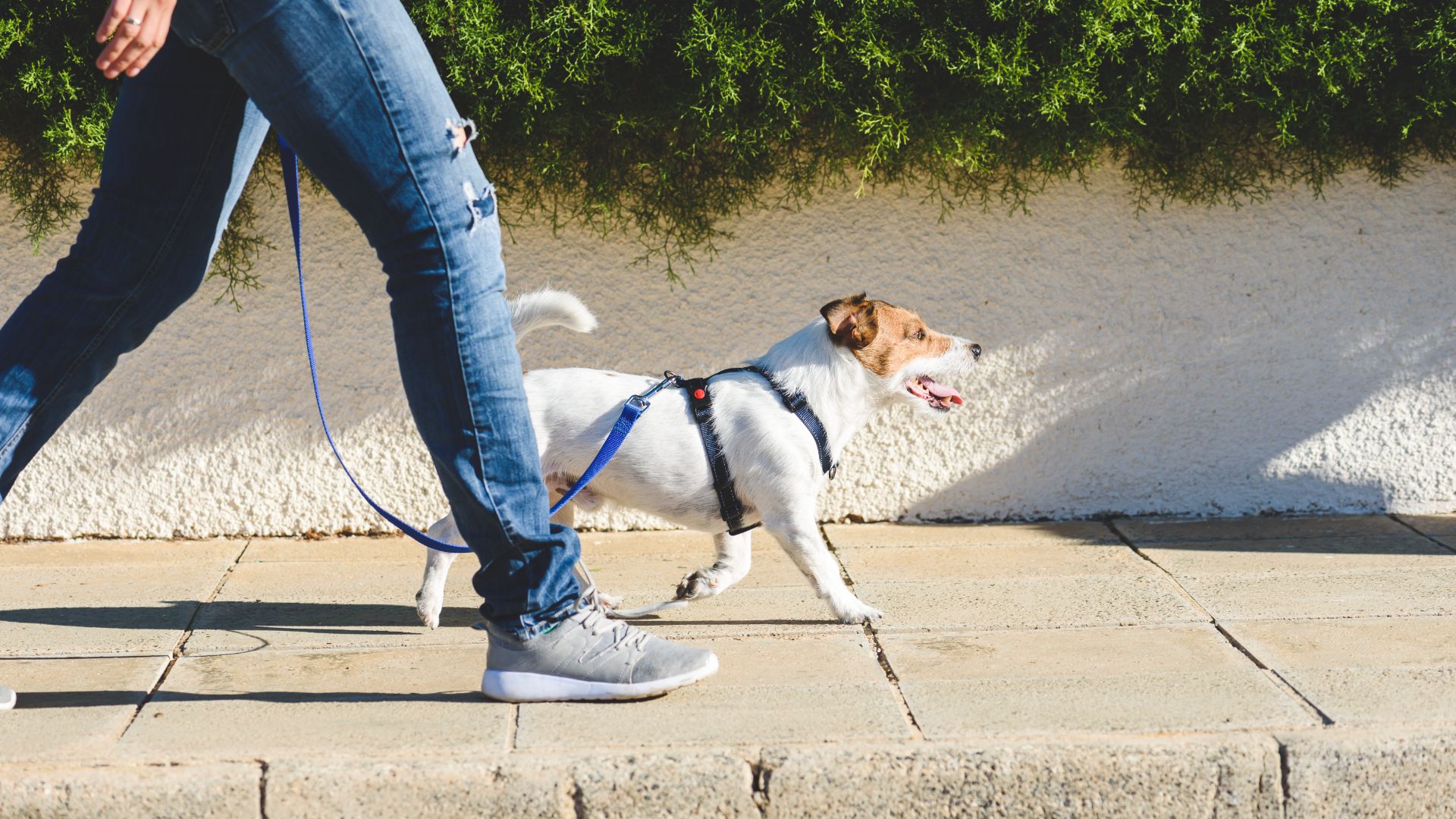How to stop a dog pulling on a leash
Wondering how to stop a dog pulling on a leash? We consulted an APDT-certified dog trainer for her top tips

Wondering how to stop a dog pulling on a leash? Having your pup relentlessly pulling ahead of you is one of the most frustrating things you can experience as a pet parent but we promise your dog isn't doing it to wind you up. In fact, there are often underlying reasons that explain why your dog is pulling on its leash.
While investing in on of the best dog harnesses for pulling is a great place to start to overcome this issue, understanding the reasons why your canine companion is doing this in the first place can be super helpful.
Thankfully, we sat down with APDT-certified dog trainer Lara Sorisi to ask her how dog owners can prevent their dogs from pulling and experience a blissfully peaceful loose leash walk instead.
Why do dogs pull on their leash?
One of the first things Lara recommends is downgrading your expectations for your dog.
“I often find that people run before they can walk – or, more accurately, walk their dog before their dog can stand still in that environment without being over-stimulated,” she explains. “It’s really important that owners build up a strong foundational training in a less exciting environment, as this will help your dog build good habits.”
A dog pulling on a leash is understandable – once you see it from their perspective. There are unusual sights and sounds all around them, with people, cars and potentially other dogs moving in different directions. Plus, there will be an incredible array of scents that will be battling with the question of how to get your dog’s attention! With so much information bombarding your dog, it’s no surprise that so many struggle to pay attention to their owner on their walks.
It’s also important to consider other factors that might be at play as well. Lara says, “When I work with a dog pulling on a leash, I often talk to the client about their dog’s gait. Leash pulling in puppies is really common, but when they’re so young their natural gait is really bouncy with their legs going everywhere. So, how can we expect them to walk calmly on a leash when they can’t do it at home?
Get the best advice, tips and top tech for your beloved Pets
Rabbitgoo No Pull Harness | Amazon
This comfy harness is made from sturdy nylon and is fully padded. Is has four adjustment points to customise fit and maximise mobility.
Starting with static training
Learning the skill of standing calmly and staying still is one dogs of all ages can benefit from.
“Even if your dog is a little older, it’s still a matter of managing your expectations. I always recommend beginning your loose leash walking training with static work so that you can understand what you’re trying to achieve – a calm dog that looks at you and engages with you. I find that people often begin walking a route before their dog is ready, but static work can be a game changer for getting your dog used to new environments.”
So, how can dog owners implement static work into their training? Essentially, you want to find an environment that your dog can sit still in without pulling, lunging or getting stressed. A good indicator of whether the environment is too taxing is if your dog is unable to take food. If this happens, retreat to somewhere less exciting until your dog is able to eat. Then, simply sit with your dog and reward them whenever they engage with you, such as looking at you or performing a desired behavior such as sitting or lying down.
In the meantime, take your dogs to private dog walking fields for off-leash exercise or use long lines (like this one on Amazon) for stress-free walks. This will prevent your dog from developing bad habits on the shorter leash.
How to stop a dog pulling on a leash

Once your dog is capable of sitting calmly in different environments, you can start working on your loose leash walking again. However, don’t forget that your walk doesn’t begin when your dog’s paws hit the pavement – it actually starts much earlier than that. Lara says, “When working with my clients, I really stress the importance of desensitizing a dog to its harness, leash and collar first. You want them to be totally comfortable with their leash walking equipment first before you introduce the element of actually walking them.
“I’ve often found that the process of putting on a dog’s harness and leash can become a trigger point for over-excited behaviors. The dogs know that they’re about to be exposed to a stimulating and exciting environment and their anticipation begins to ramp up. However, if we put in the effort to desensitize them to this process, then we can make sure that they leave the house in as calm a state as possible. Think about it this way – if the dog is bouncing around when you’re leaving the house and you can’t easily put a harness on, why would they calm down and walk nicely on their leash during the walk itself?”
Here are more tips on how to put on a dog harness easily.
Auroth Tactical Training Harness | Amazon
We awarded this harness best overall in our buying guide to the best dog harnesses for pulling. It's easy to adjust, built to last and has Molle strips on both sides so your dog can carry essentials.
Using treats to leash train your dog
So, you’ve created a calm process for leaving the house and you’ve done plenty of static work to get your dog used to the environment outside – now what? Well, you’re going to want a pocket-full of the best dog treats. Beginning in a quiet outside environment (don’t be tempted to try this first on a busy road), walk calmly along with your dog and reward them any time that they look at you. This will discourage a dog pulling on a leash to charge ahead and instead encourage them to stay close, as they’ll want the treats.
If your dog hits the end of the leash, there are a few common tips to try out:
- Stop and stand still until your dog returns to you – you can then give them a treat and begin walking again.
- Turn and start walking in the opposite direction – once your dog is loose leash walking again you can give them a treat.
- Turn your dog around in a circle until they’re facing the original direction you were walking in – this can often ‘reset’ the dog. Again, give them a treat when they begin loose leash walking again to tell them that they’re doing what you want.
Pupford Beef Liver Training Freeze-Dried Dog Treats | Chewy
We gave these to our tester Isaiah for his dog Hayes to try. He reports back that they're his new favorite treat and are a suitable size for training. "He could and would eat the whole bag if allowed!"
If you find that your walk is becoming very stop-start, then you may need to consider that your dog just isn’t quite ready to transition from static training to walking. This is where you might want to take a step back and do more static training so that neither you or your dog become frustrated. Keeping your training sessions positive is essential, as your dog will be much more likely to want to work for you.
For more great training tips, check out our guides on how to crate train a dog and how to reduce separation anxiety in dogs.

Lara Sorisi is a science-based and force-free dog trainer that has been working with dogs for many years. She is accredited by the APDT (Association of Pet Dog Trainers), which is one of the most rigorous dog training qualifications available. Lara holds a bronze-level qualification with UK Sniffer Dogs, which means that she is an accredited UK Sniffer Dogs instructor. Lara has trained her own dogs to be trial winners and dedicates her time to helping other dog owners in group and one-to-one sessions.
Louise Carey is a freelance writer and the Editor of sister website Top Ten Reviews. She has been working in publishing for seven years, contributing to publications including The Independent, TechRadar, Digital Camera World and more. As the proud pet parent of a reactive border collie with a food allergy, it’s been necessary for Louise to explore a variety of fun and exciting ways to enrich an energetic dog that can’t always go on walks. She’s passionate about sharing the information she’s learned to help other pet owners as well.
- Bethany StoneFreelance Writer




